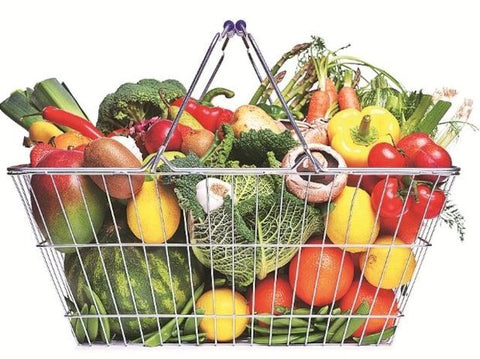In general, we think that eating healthy and well is very complicated, expensive and unsustainable, because it requires a lot of cooking and because we don't know where to start...
It is true that eating well every day requires knowing the basics of healthy eating and that there is currently so much information that contradicts each other that we end up getting confused... but there are some aspects necessary to be able to have a healthy diet and eat well every day.
What does "a healthy diet" mean?
Although we all know some basic guidelines for eating better, the truth is that we often do not have the necessary tools to learn how to organize a healthy, varied and balanced diet.
The concept is very complex, since cultural, social and economic factors influence it, but there are certain common patterns that characterize it. Eating healthily means being able to follow a dietary pattern that includes a variety of nutritious foods, as well as ensuring that our body obtains the right amount of calories for each of us and stays hydrated.
According to the World Health Organization , “A healthy diet helps protect us from malnutrition in all its forms, as well as non-communicable diseases, including diabetes, heart disease, stroke and cancer.”

What should a healthy diet be like?
A healthy diet should be:
Balanced . It must provide nutrients in the appropriate proportion to the needs of each person according to their age, sex and life situation.
Sufficient . Should include the amount of food needed to provide nutrient and weight maintenance.
Varied. It must include a variety of foods that ensure that all nutrient needs are met.
Appetizing . It must be conducive to long-lasting enjoyment, as well as activating the senses. That is, vision, smell and taste.
Sustainable. This factor must be taken into account when purchasing food and its impact on the environment.
Thus, for a diet to meet these characteristics, it must include foods that make up a healthy diet due to their high content of nutrients that are beneficial to the body, such as antioxidants, vitamins and minerals, fiber and unsaturated fats, such as oleic acid and omega-3. Vegetables and greens, fruits, whole grains, olive oil, legumes, nuts, fish and seafood, eggs, dairy products and white meat.

Guidelines for preparing healthy menus
1. Prepare tasty and healthy dishes
As long as we enjoy intestinal health, vegetables should be the basis of our diet, accounting for 50% of the plate . Vegetables can be included raw in the form of salads or cooked (steamed, blanched, sautéed, baked, grilled) and combined with other foods. When eaten raw, as in the form of salads, it is best to do so at midday; cooked vegetables, on the other hand, are recommended at night as they are easier to digest.
Once we have half of our plate filled with vegetables, we include 20% of protein-rich foods, such as eggs and legumes (which are also a source of carbohydrates) or, if you follow an omnivorous diet, fish, seafood or poultry.
20% of your plate should include foods rich in healthy fats , such as avocado, extra virgin olive oil (AVOE), various whole or ground seeds, nuts, olives (always preferably organic), etc. Different sources of healthy fats can be combined.
2. Opt for “good” carbohydrates.
We also add to the plate a portion of foods rich in carbohydrates, which can come from vegetables such as pumpkin, carrot, beetroot, parsnip; from tubers such as potato, sweet potato or yuca or from grains such as brown rice and buckwheat, which stand out for having fewer antinutrient substances than quinoa or millet, for example. In any case, if these grains are prepared correctly, leaving them to soak, washing them and cooking them with plenty of water, we can also add them to our weekly diet.
Finally, you can use seasonings such as herbs, both fresh and dried, spices, sprouts, fermented foods such as kimchi and sauerkraut, and a good dressing to add flavor, add nutrients, and increase the absorption of fat-soluble vitamins.
3. Base your diet on vegetables
At the base of our pyramid we should place the vegetables , especially the green leaves and those with a bitter taste (kale, arugula and lamb's lettuce, escarole, endives, watercress, artichokes, cucumber, celery, asparagus or fennel, among others).

Green leafy vegetables are rich in nutrients and regular consumption of vegetables guarantees both a supply of fibre necessary for intestinal transit and for the bacteria in our intestine.
It is also a way to add substances with antioxidant action to our daily diet, since onions and leeks are rich in quercetin; red cabbage and beetroot are rich in anthocyanins; tomatoes (especially if we cook them) are rich in lycopene; and orange vegetables are rich in beta-carotene.
4. Cooking at home
We will always enjoy better health if we process food at home, since we know the quality of all the ingredients we eat every day.
In addition, every time we decide to cook at home, we are betting on our health, which means you will have to plan and prepare a menu, a shopping list and prepare the dishes.
5. Plan the menus
To make menus easier and vary them throughout the month, you can set a day of the week for a food, for example, on Mondays it's chickpeas. So, throughout the month, on Mondays you can cook different recipes such as falafels, hummus, salad or stews with vegetables.
With good planning, once we have the basic menu, it is easier to prepare the shopping list and allows us to optimize time in the kitchen whether we cook once or twice a week (batch cooking), or cook a little each day.

If we have planned a menu that we adapt throughout the month, it also allows us to better organize fresh foods, canned goods, frozen and refrigerated products.
6. Cook them in a healthy way
The priority in the kitchen will be to prepare food without spoiling its nutrients and without harmful substances appearing due to the cooking process . For example, grilling is a good way to prepare vegetables, but it is better to put the vegetables on the grill when it is not completely hot and cook them on the lowest heat.
Steaming vegetables is another recommendation because by not being in contact with water, the water-soluble vitamins and minerals are preserved much better.
7. Be careful with sugar and salt
Most people consume too much sodium through salt (an average of 9 to 12 g of salt per day) and not enough potassium (less than 3.5 g). Too much salt and not enough potassium contribute to high blood pressure, which in turn increases the risk of coronary heart disease and stroke.
Excess calories from foods and beverages high in free sugars also contribute to unhealthy weight gain, which can lead to overweight and obesity. Recent scientific evidence shows that free sugars influence blood pressure and serum lipids, and suggests that reducing their intake reduces risk factors for cardiovascular disease.
The WHO recommends controlling these products in our diet and gives us different guidelines .

https://www.mayoclinic.org/es/healthy-lifestyle/nutrition-and-healthy-eating/basics/nutrition-basics/hlv-20049477
https://www.who.int/es/news-room/fact-sheets/detail/healthy-diet
https://www.clinicbarcelona.org/noticias/consejos-para-elaborar-un-menu-saludable?gclid=EAIaIQobChMImoDc95qDhAMV0pODBx0mgwgPEAMYASAAEgIYi_D_BwE
https://www.eufic.org/es/healthy-life/articulo/10-consejos-para-alimentacion-saludable
https://www.cdc.gov/nccdphp/dnpao/features/healthy-eating-tips/index-es.html
https://www.mapfre.es/ahorro-inversion/planes-de-pensiones/articulos/alimentacion-saludable/




Comments (0)
There are no comments for this article. Be the first one to leave a message!